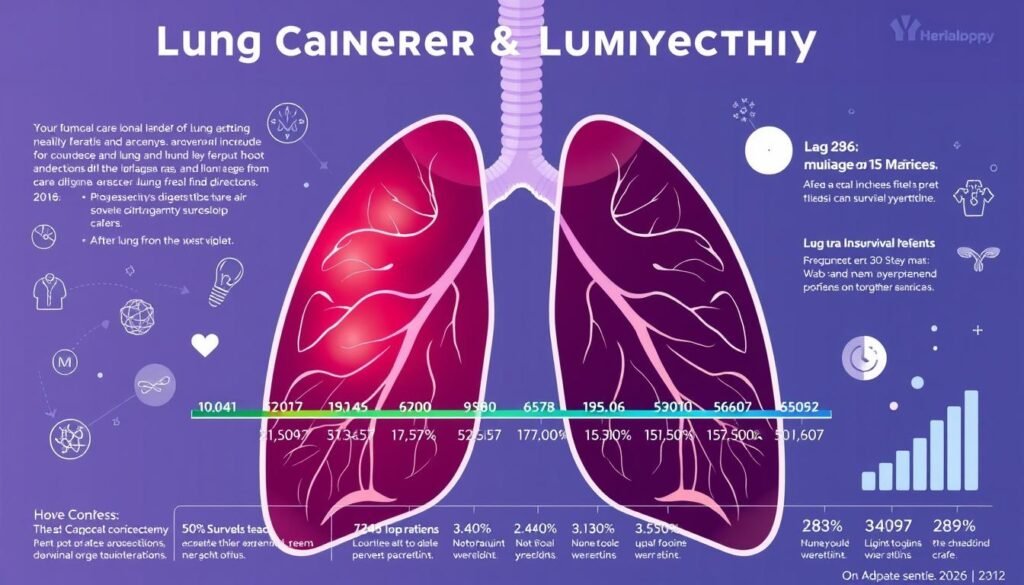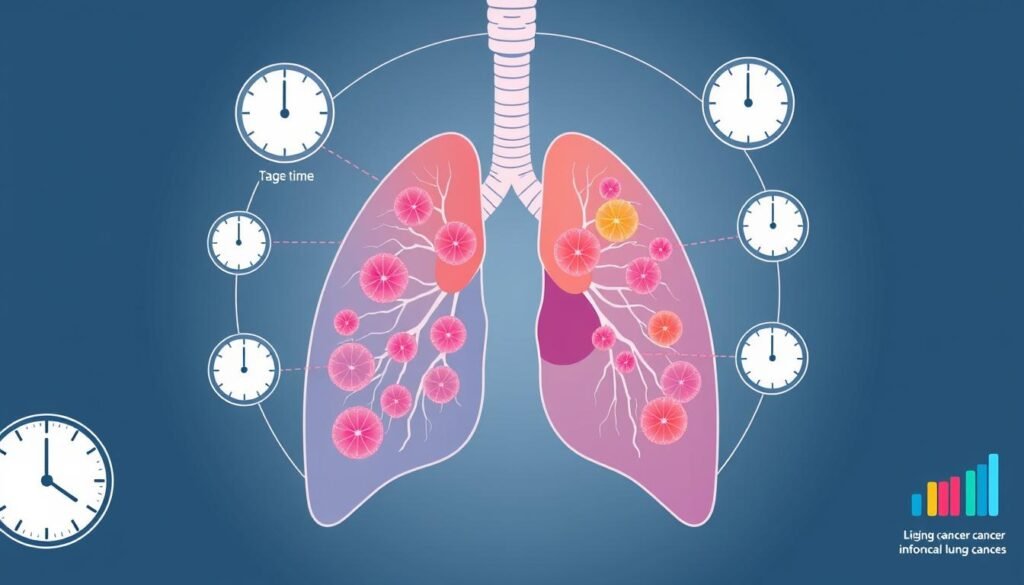Did you know about half the people with lung cancer who have surgery survive five years or more? They have a 78.9% chance after a lobectomy. This fact shows how effective lung cancer surgery can be. It also highlights why it’s important to know about lobectomy survival rates. With an 80.4% survival rate after 10 years for certain lung cancer patients, surgery brings hope. This is especially true when lung cancer is found early.
We want to explore lung cancer lobectomy survival rates more here. We’ll look at both short-term and long-term results. Knowing the risks of a lobectomy is crucial. It helps patients and doctors make better choices. Understanding these rates helps patients choose their treatment wisely. It also encourages them to live healthier lives.
Key Takeaways
- The five-year survival rate for lobectomy patients is approximately 78.9%.
- Early detection significantly improves survival outcomes.
- Patients with clinical T1 N0 lung cancer have a 10-year overall survival rate of 80.4%.
- Understanding lobectomy procedure risks is crucial for planning treatment.
- Lung cancer surgery outcomes can vary based on individual health conditions.
- Healthy lifestyle changes, such as smoking cessation, can positively influence survival rates.
Understanding Lung Cancer and Lobectomy
Lung cancer comes in two main types: non-small cell lung cancer (NSCLC) and small cell lung cancer (SCLC). NSCLC makes up about 85% of cases. The rest are SCLC. Knowing the differences between these types is key for the right treatment plan.
Lobectomy is a surgical method to remove a lung lobe affected by cancer. Its goal is to take out the cancer and help the patient live longer. Thanks to advances in medicine, lobectomy has become a top choice for treating lung cancer.
Lobectomy leads to less deaths when compared to other surgeries. For example, only 3.5% die after a lobectomy. But, death rates for simple pneumonectomy are at 20%. Radical pneumonectomy has an even higher rate, between 15% to 25%. These numbers show why picking the right surgery is crucial.
Early detection of lung cancer has made lobectomy a key option. Data shows this surgery has a 5-year survival rate of 41%. This proves it’s an effective way to extend patients’ lives. It stresses the need for further research to better treatment results.
In conclusion, it’s important to know about lung cancer types and how lobectomy can help. Choosing the right surgical method can greatly improve a patient’s chances for a longer life.
What is a Lobectomy?
A lobectomy is surgery to remove a whole lobe of the lung. It’s mainly for treating early-stage lung cancer. This increases chances of survival if the cancer is only in one lobe. The surgery often uses minimally invasive methods like VATS. These methods make recovery quicker and lower risks after surgery. It’s important to know about different lobectomy types, like wedge resection and segmentectomy.
Lobectomies are often chosen over more extreme surgeries like pneumonectomy. This is because they’re less harsh on lung function after surgery. Studies show lobectomy patients have better survival rates than those who get radiation therapy. After three years, lobectomy patients do better and have lower rates of cancer coming back. Advances in surgery now offer treatments better suited to each patient. This improves care for those with lung cancer. For more on lung cancer surgery advancements, see this resource.
| Outcome | Lobectomy Patients | SBRT Patients |
|---|---|---|
| 3-Year Survival Rate | 92.8% | 59.0% |
| 3-Year Recurrence Rate | 7.1% | 21.0% |
| Average Age | 65.5 years | 73.7 years |
| Comorbidities | 64% | 75% |
Want to know more about the lobectomy and what it entails? Check out this detailed guide here. It shows that the more skilled the surgeon, the higher the chance of surviving lung cancer after a lobectomy.
The Importance of Early Detection
Early detection of lung cancer is key to improving patients’ survival chances and their treatment results. Thanks to new imaging tech, like low-dose CT scans, doctors can now find smaller tumors early. This greatly improves the success of treatments available.
Screening programs focus on those most at risk, like people 50 to 80 who smoked a lot. Groups like the U.S. Preventive Services Task Force and the American Cancer Society recommend yearly screenings. These screenings are proven to catch lung cancer early. Patients found through screenings could have a survival rate of 81% over 20 years, showing the value of acting early.
The survival rates for lung cancer vary greatly depending on when it’s caught. For example, 92% of stage IA NSCLC patients live five years or more. But, only 10% of stage IV patients can say the same. This shows how vital early detection of lung cancer is for a better outcome.
About 85% of lung cancers are nonsmall cell lung cancer, making early screening key. Sadly, only 16% of lung cancers are found early. This leads to over half of patients passing away within a year of being diagnosed. More people knowing about and getting screened could change these numbers.
To wrap up, including lung cancer screening in regular care for those at high risk is essential. It helps more patients get effective treatment early, raising survival rates and improving lives.
Lung Cancer Lobectomy Survival Rates
Lung cancer lobectomy improves survival for many. It offers hope and direction during treatment. The outlook depends on medical factors, the cancer’s stage, and personal situations.
5-Year Survival Rates
The 5-year rates for stage 1 non-small cell lung cancer (NSCLC) are hopeful. For stage 1 NSCLC, rates range between 70% and 92%. The TNM system helps define these rates for stage 1 diseases as follows:
| Stage | 5-Year Survival Rate |
|---|---|
| 1a1 | 92% |
| 1a2 | 83% |
| 1a3 | 77% |
| 1b | 68% |
Long-Term Survival Rates
For those with early-stage lung cancer, 10-year survival rates reach about 80%. Early detection hence plays a vital role. It stresses the importance of detailed cancer staging and assessment.
Factors Influencing Survival
Diverse factors impact lung cancer survival rates. Key influences include:
- Tumor Size: Bigger tumors tend to mean lower survival.
- Histological Type: NSCLC types vary in 5-year survival rates. Lung adenocarcinoma stands at 20.6%, while squamous cell carcinoma is at 17.6%.
- Lymph Node Involvement: Survival drops with positive lymph node status.
Knowing these aspects helps in planning treatment and understanding potential results.

Risks Associated with Lobectomy Procedures
Lobectomy is a surgery for lung cancer with some risks. Both patients and healthcare workers need to know these risks. Understanding lobectomy risks and surgical complications improves safety after surgery.
What Are the Common Risks?
Common risks of lobectomy include:
- Morbidity rates from 10% to 50%
- 15% to 18% of patients have prolonged air leaks
- 1.1% may get Empyema
- Approximately 2.5% develop pneumonia
- 0.5% may have a bronchopleural fistula
- 0.7% might experience acute respiratory distress syndrome (ARDS)
- 6.4% can have atelectasis
- 14.4% might get atrial fibrillation
- The overall mortality rate is 2.6%
These numbers show how important careful evaluation before surgery and careful watching after surgery are.
Managing Surgical Risks
How we manage risks can really reduce complications. Important steps include:
- Checking patient health and surgery readiness before operating
- Using the best surgical methods and training to reduce surgical complications
- Watching patients closely after surgery for any early signs of complication
- Creating recovery plans that are aimed to increase patient safety post-surgery
Using these steps makes complications less likely. For example, about 1.5% of surgeries need another operation for bleeding. This shows why we need to keep a close watch after surgery.
| Complication | Incidence Rate |
|---|---|
| Morbidity | 10% – 50% |
| Prolonged air leak | 15% – 18% |
| Empyema | 1.1% |
| Pneumonia | 2.5% |
| Bronchopleural fistula | 0.5% |
| ARDS | 0.7% |
| Atelectasis | 6.4% |
| Atrial fibrillation | 14.4% |
| Mortality Rate | 2.6% |
Understanding and managing these risks leads to safer surgeries and better recovery. This highlights the important role of careful surgical practices.
Lung Cancer Staging and Survival Rates
Lung cancer staging helps doctors make good treatment plans. It predicts how long patients might live. The TNM system is used most often for staging. It looks at tumor size (T), if cancer has spread to lymph nodes (N), and if it has spread to other parts of the body (M).
Those with early-stage lung cancer have a much better chance of surviving. For example, people with Stage IA1 non-small cell lung cancer have a 97% chance of surviving two years. But for Stage IB, this drops to 89% at five years. The survival rates fall significantly for those in advanced stages. Just 10% of Stage IVB patients live five years after being diagnosed.

| Stage | 2-Year Survival Rate | 5-Year Survival Rate |
|---|---|---|
| Stage IA1 | 97% | 90% |
| Stage IIB | 76% | 56% |
| Stage IIIA | 65% | 41% |
| Stage IVB | 10% | 0% |
These numbers show a clear link between the stage of lung cancer and the outcome for the patient. Knowing all about lung cancer stages lets doctors create the best treatment plans. This improves survival chances for those facing this tough disease.
Post-Lobectomy Prognosis
After lung cancer surgery, understanding the recovery process is key. Patients face common issues that must be tackled for effective healing. These include pain control, breathing, and adjusting to changes in health.
Common Recovery Concerns
Patients often deal with problems like:
- Pain management: Controlling pain is crucial for a better recovery.
- Respiratory function: Breathing difficulties may need special care to aid lung health.
- Physical mobility: Movement can be limited, highlighting the need for careful physical activity.
Strategies for Improved Outcomes
Effective rehabilitation is key in lung cancer surgery recovery. Employing various strategies helps enhance this process.
- Physical therapy: A custom program helps rebuild strength and improve breath.
- Pulmonary rehabilitation: These programs guide patients to better lung function with exercises and education.
- Follow-up care: Regular check-ups are crucial to monitor for cancer recurrence and tweak rehab plans.
Focusing on these strategies improves the journey after surgery. It leads to higher quality of life and survival rates.
| Recovery Concern | Recommended Action |
|---|---|
| Pain management | Use effective pain relief meds and methods. |
| Respiratory function | Do breathing exercises and therapies. |
| Physical mobility | Gradually increase activity with a structured plan. |
| Monitoring | Go to regular health checks. |
These methods improve recovery and surgical results in lung cancer patients.
Minimally Invasive Lobectomy Techniques
Minimally invasive surgery has changed how lung cancer is treated. Techniques like video-assisted thoracic surgery (VATS) are now more popular. Patients see great benefits, like less pain and quicker recovery times.
Recent studies looked at 844 lung surgeries. Of these, 436 were done with VATS and 234 with robotic-assisted thoracic surgery (RATS). VATS patients had a five-year disease-free survival (DFS) rate of 60.9%. For RATS, it was 52.7%. This shows VATS is a good choice for those wanting less invasive options.
Another study compared segmentectomies. It showed VATS had an 84.6% three-year DFS rate. RATS had just 72.9%. This suggests that VATS can be more effective in treating some lung cancers.
People who had minimally invasive surgery stayed in the hospital for less time. On average, they stayed 7.15 days. Those who had open surgery stayed longer, about 8.40 days. Both groups had similar five-year survival rates: 53.1% for the minimally invasive group and 51.3% for open surgery.

The future of thoracic surgery looks promising thanks to these less invasive techniques. They show great promise in improving patient outcomes after lung cancer surgery. This brings hope for better care and faster recovery for patients.
To learn more about minimally invasive lung cancer surgery, visit this study.
Long-Term Lung Cancer Remission Rates
Understanding long-term remission rates for lung cancer after surgery is key for both patients and doctors. More than 68% of lobectomy patients may be in remission after 10 years. This is hopeful news, showing how long remission can last.
However, many patients may see their cancer return. That’s why keeping an eye on one’s health post-surgery is important. Through regular check-ups, doctors can catch any changes early. Patients are also urged to quit smoking and eat healthily to lower risks.
The care received before and after surgery deeply affects outcomes. Age, how early the cancer is found, and general health play roles too. Talking often with doctors about your health and treatment choices is crucial.
| Stage | 5-Year Survival Rate (%) | Notes |
|---|---|---|
| Stage 2a | 60 | Survival rate under various systems offers a hopeful outlook. |
| Stage 2b | 53 | Recurrence becomes a more pressing concern. |
| Stage 3 | 36 to 13 | Varies greatly by subtype; treatment impacts outcomes. |
| Localized NSCLC | 65 | Highest survival rates noted, emphasizing early detection. |
| Distant NSCLC | 9 | Challenges in management lead to much lower rates. |
To sum up, there’s hope for those undergoing lung cancer surgery. But staying active in your care and making healthy life choices are key to longer remission and survival.
Conclusion
The research shows lobectomy as a key treatment for early lung cancer, especially non-small-cell lung cancer (NSCLC). The 10-year survival rate for those with stage IA NSCLC after lobectomy is 58.3%. Plus, the specific survival rate for lung cancer is 74.3%. These facts underline the need for careful treatment choices, considering factors like age and lung health.
Early detection and better surgical methods are crucial for improving outcomes. Data shows that lung cancer is a major cause of death even after surgery. However, picking the right patients for surgery can lower risks. People who have a lobectomy often live longer than those with less extensive surgery. This shows how important lobectomy is for many patients.
Doctors must keep updating surgical techniques to offer tailored treatments. Looking into surgical results more will help sharpen these treatments, helping patients live better lives. For more details on surgery and the risks, check this research article.